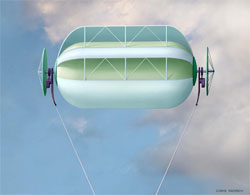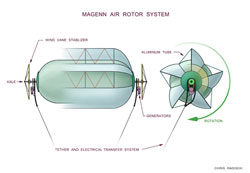Making wind power less deadly for birds
Rhett A. Butler, mongabay.com
December 15, 2005
High oil prices and concern over climate change are driving interest in renewable energy technologies. All types of potential power sources — not limited to the sun, ocean tides and waves, raw sewage, and even insects — are the focus of media reports, while governments and industry scramble to announce their grand plans for adopting green energy.
Lately some questions have been raised over the true environmental impact of some of these energy sources. Environmental groups have recently criticized the clearing of natural forests in southeast Asia and Brazil for oil palm plantations and soybean farms that may used in the production of biomass-based fuels. Similarly, some environmental groups are worried that wind power — one of the most promising sectors for immediate renewable energy production — is responsible for deaths of migratory birds.
According to a recent review of literature, wind generation facilities kill 10,000 – 40,000 birds a year. While these figures are minuscule in comparison to the numbers of birds killed by windows, power lines, vehicles, and communication towers, they are still significant to be of concern to some groups, especially in areas where charismatic birds of prey are the victims. In California, environmentalists have sued turbine owners to take protective measures which eat into their bottom lines and are of questionable effectiveness.
A Canadian firm has taken a different approach to harnessing wind power, one that potentially reduces associated bird mortality while addressing some of the other shortcomings of traditional wind turbines.
Instead of giant wind turbines — which average over 250 feet (80 meters) in diameter — Magenn Power Inc. uses a tethered lighter-than-air device that rotates about a horizontal axis in response to wind. The Ottawa-based firm says that its Magenn Power Air Rotor System (MARS) efficiently generates clean renewable electrical energy at a lower cost than other wind turbine systems while potentially reducing mortality of birds and bats. Further, because the helium powered units float at altitudes from 400-ft to 1,000-ft (125-310 m) above ground level they can capture the stronger winds than conventional wind turbines.
 For grid or off-grid use, Magenn Power’s “Floating Wind Generators” could be ideal says Mac Brown, CEO of Magenn Power. Images courtesy of Magenn Power. |
The units are also mobile, meaning they can be easily moved to different locations to correspond to changing wind patterns or placed closer to demand centers, thus reducing transmission line costs and transmission line loses. Mobility is also useful in emergency deployment and disaster relief situations where small to medium sized systems could be air-dropped for emergency electrical power. Magenn says that a backpack version could even be deployed by a hiker, motorist, boater, or solider.
For more on Magenn Power’s system, check out www.magenn.com/technology.php.
Related articles
Harvesting tornadoes as power plants; renewable wind vortex energy
Engineers are working to use artificial tornadoes as a renewable energy source according to an article in last week’s issue of The Economist. Storms release a tremendous amount of energy. Hurricane Katrina, a category 4 hurricane, released enough energy to supply the world’s power needs for a year, while the typical tornado produces as much power as a large power station.
Britain has best wind power potential in Europe
A survey of wind power in Britain says the island nation has the best wind in Europe because it blowsyear round and peaks when there is greatest demand for electricity. Further, the study found that there has never been a time over the past 35 years when the entire country has experienced a period of no wind.
Renewable energy in China, a strategic future?
With a host of environmental and domestic social concerns — and potential future international conflict — China could be well suited to pursue renewable energy sources. China’s failed bid for American petroleum firm Unocal may prompt it to further focus on its development of alternative energy sources. The country has recently passed a renewable energy law that requires power operators to buy electricity from alternative energy producers and the government has increased spending for research on wind, solar, biofuel, and tidal technologies. .
China to add wind power capacity
In recent years China has significantly expanded its interests in renewable energy sources including wind, solar, biofuels, tidal, and small hydroelectric dams. Below is an article from the Associated Press on a planned expansion of the country’s wind power capacity.
Australian industry embraces green energy while government fights emissions cuts
Despite Australia’s resistance to limiting carbon dioxide emissions through the Kyoto Protocol, Australian industry and entrepreneurs are working on novel ways to reduce dependence on traditional fossil fuels.

